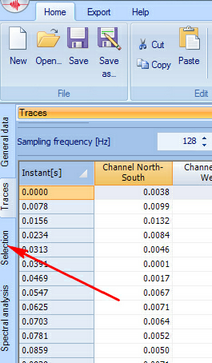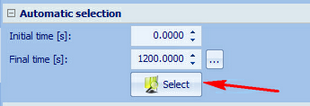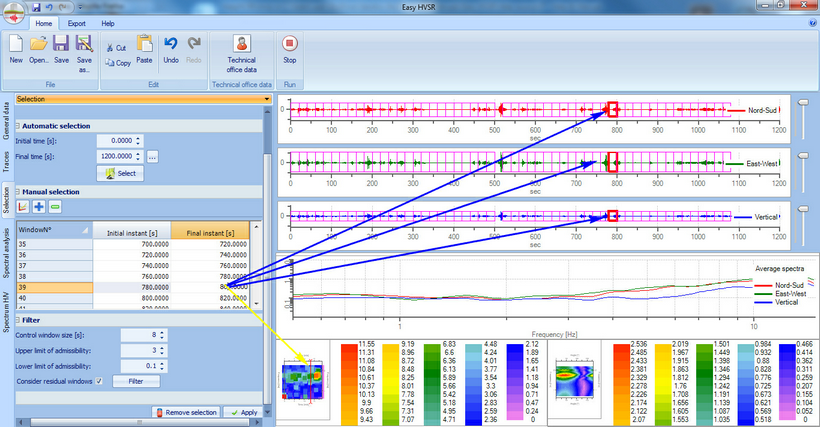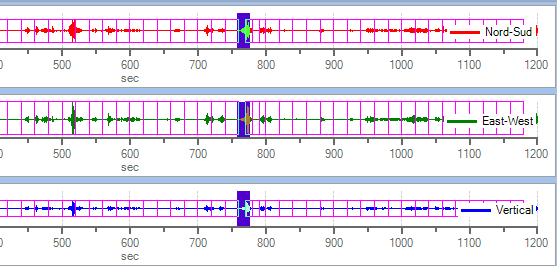Step 2 - Selecting time windows
In this step of the tutorial we will see how to select the time windows to be employed in the process of elaboration.
It is possible to load the file "Step_1" in the folder of the tutorial, containing the data necessary to proceed from this point of the tutorial forward.
1) |
Click on the tab related to the "Selection" |

2) |
In the section "General data windows" (image below), you can enter a value for the time dimension of the windows in which to subdivide the entire recording (red arrow). In this tutorial we will leave this unchanged for the time given, but for more details you can refer to the relevant section of this manual. |

3) |
In the section "Automatic selection" you can change the values of the initial and final instant, identifying the range of the recording that will be split automatically in the windows, through the procedure that is launched by the "Select" button shown in the following image: |

In this case will work the whole recording that has precisely a duration of 1200 seconds (20 minutes).
4) |
Immediately after performing the automatic selection you should get a screen similar to the one shown in the picture
|

5) |
In the three graphics above you can see how the automatic selection has divided the traces of the three channels in more recordings of length equal to that reported in the "Window size" field. This field will be changed now showing a value of 32, in agreement with the number of samples of the recording, so as to make possible to use the Fourier fast transform. Each rectangle in the above graphics represents one of these windows in which the entire recording was divided. The middle graphic instead, shows the average spectra of each trace, mediated notes on the windows just generated. |
6) |
Before you perform a manual selection of windows to include or exclude from the process of analysis, it is convenient (but not always necessary or appropriate) to apply the filter function to discard those windows that contain records of transients. |

7) |
To calibrate the parameters in this section please read the relevant information contained in this guide regarding the filtering technique. Strictly for the purposes of this tutorial, we will enter in the field "Control window size" the value 8. Then pressing the button "Filter", results the following: |

In practice, the time window which contained the record which ranged from 512 seconds to 544 seconds was discarded because the procedure has identified the peaks to be considered not good for the calculation.
8) |
Even if the automatic procedure has its effectiveness, it is sometimes necessary to refine the result manually, going to discard those time windows in which are visibly present peaks that can not be considered representative of an undisturbed environment condition in which it is carried out recording. The presence of industrial machinery or the passage of the cars in the vicinity of the point where recording is performed alter the "normal" condition of the site under investigation. Which is why it is preferable to eliminate these peaks that would make the process of analysis difficult and even not trusted. Are identified those windows which are considered " disturbed ". In our case, the windows which should be further discarded are those that are around at approximately 50 , 180 and 780 seconds. Clicking inside of the window on any graphic of the traces, this window is highlighted, and in the table of the windows is highlighted the line associated with it containing the initial and final instant of the window. |

In the picture above the blue arrows show the correspondence of the table with the selected window, while the yellow one shows the correspondence of the table with the stationarity map showing the trend of the H/V spectral ratios of each window, side by side in chronological order. This map will be analyzed and used in subsequent steps of the tutorial where it is explained the great utility.
9) |
Once you select the window in the table, even by graphic synchronization, with the button
|

10) |
If by chance we had mistakenly deleted a window, or if we wanted to add one manually there are two procedures: |
The first is the manual entry of the initial instant of the window, using the dialog box that appears by pressing the button "Add window" having the following icon ![]()
The other provides for placing directly on the graphic. Clicking the button "Add to diagram" having the following icon ![]() and clicking and holding the left mouse button on one of the graphics of the traces you get an image similar to the following:
and clicking and holding the left mouse button on one of the graphics of the traces you get an image similar to the following:

While holding down the mouse button you can move along the direction of the x-axis of the traces: a rectangle as in the image above follows the mouse pointer, showing where would be placed in the time window that will be added to the release of the mouse button.
If you added a window, select it and then remove it in order to get the result that you expect from this tutorial. Alternatively, you can upload the results directly from the file associated with the step of the tutorial in its file.
11) |
After that press the button "Apply" and save the work done so far.
|
|
© Geostru